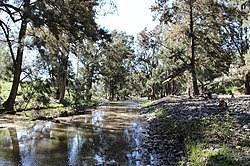7. CLIEFDEN CAVES WARM SPRING
The Belubula River at the warm spring site
In the early days shells were collected for burning around Sydney, but the supply was always inadequate. Evans' discovery showed that limestone could be found in the newly discovered country. See also my blog on the Limekilns area near Bathurst.
Surveyor General John Oxley reported soon after "The limestone, which is the first that has hitherto been discovered in Australia, abounds in the valley where we halted ; the sides and abrupt projections of the hills being composed entirely of it, and worn by the operation of time into a thousand whimsical shapes and forms. A small stream runs through the valley, which in June 1815 was dry; the bottom of this rivulet was covered with a variety of stones, but the bases of the hills which projected into it, and from which the earth had been washed were of pure limestone of a bluish grey colour.
June 24.-A fine mild morning. A small piece of limestone which had been put in the fire last night was found perfectly calcined into the purest white lime."
There is an extensive report on this area in the Sydney Morning Herald Wednesday 6th September 1876. See 06 Sep 1876 - BELUBULA CAVES. - Trove (nla.gov.au) . Of special interest to us is this paragraph near the end:
"Near the Belubula River, on Mr. W. M. Rothery's estate, and about three miles north from the caves, there is a hot spring from which Mr. Rothery informed me that a volume of water at a temperature of 88 degrees Fahrenheit issues at the rate of about 70 gallons per minute That it contains lime in solution is evident from the calcareous tufa deposited from it. This spring is said to have been running in the same manner ever since it was discovered, more than thirty years ago. lt is, no doubt, an outlet for the water collected by some of the numerous caves in this limestone country, the water becoming heated in its passage through the rocks at considerable depths."





Comments
Post a Comment